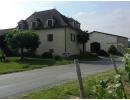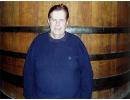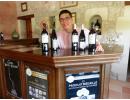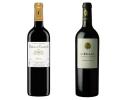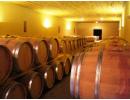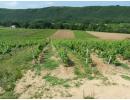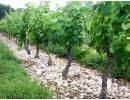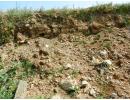Chateau La Coustarelle
Château la Coustarelle "Grande Cuvée Prestige" - Cahors
This is the main wine of the estate, a blend of 90% Malbec with 10% Tannat. The vines are an average of 30 years old planted on the best soils of the 3rd terraces covering 20 ha. The yield is 50 hl/ha. The grapes are destemmed before the fermentations and the two grape varieties are fermented separately for 3-4 weeks in stainless steel vats at 28°C. Following the fermentations, the Malbec and Tannat will be aged for 12 months in stainless still vats for the wine to settle and then a further 12 months in french oak barrels (medium toast) renew by 1/4 each year. No filtration and fining are carried out before bottling.
PVins notes: The wine's colour is "noir" (black), the nose is complex with spices and notes of blackberries with hints of mint and mocha. The wine is well structured, with a good concentration of tannins that are well integrated, enabling the wine to be consumed in its youth. It is advisable to cellar the wine for 2-3 years before opening a bottle but its ageing potential is up to 10+ years. Alternatively, if you cannot wait to drink the wine upon release, decanting it for a couple of hours is recommended.
Château la Coustarelle "L'Eclat" 2011 - Cahors
A premium wine made with old vines of Malbec following a selection of the best parcels on clayey-limestone soils, situated on the famous 3rd terraces at the lieu dit "Miloune" near Prayssac. The winemaking process is classic, following the sorting the grapes are destemmed and the pressed berries will undergo a skin maceration at a cold temperature for 3 days to extract extra colour, flavours and improve the structure of the future wine. The fermentations will last about 20 days in stainless steel vats at 28°C. The wine is aged for 21 months in new french oak barrels of 220 litres. No filtration and fining are carried out before bottling. "L'Eclat" is only produced if the vintage conditions allow a high quality cuvée.
PVins notes: A great premium Malbec wine that shows what Cahors is all about. Dark purple in colour, a complex nose with black fruits and hints of toasted oak with mocha aromas. Impressive power on the palate, well structured and balanced with elegant fine grained tannins. A long finish with fresh blackcurrant and spice flavours. It is recommended to cellar the wine 5 years upon its release to tame the tannins and let its aromatic potentials come through. "L'Eclat" may be cellared over two decades, decanting is favourable when drank in its youth should you not have the patience.
Château La Coustarelle is located on the right bank of the Lot river near the village of Prayssac at the lieu-dit "Les Caris", situated about 20 kilometres west of the village Cahors. The domaine's origins date back to 1870 when Paul Cassot settled in the area as a farmer. The farm was renamed Château La Coustarelle in 1947 by Pierre Cassot representing the 3rd generation. The château was named after the first parcel of vines planted at the lieu-dit "Coustarelle" meaning little slope "petit côteau" in old french. In 1980, Michel Cassot took over the running of the estate from his father Pierre with the help of his wife Nadine, making him the 4th generation on the estate.
In 1992, Michel decided to produce and bottle his own wines leaving the local cooperative. He invested a lot of time and effort in build the reputation of Château la Coustarelle. By the late 1990s, the estate is considered to be amongst the best estates of Cahors as it had been selected with 12 other estates (amongst 200) to have its vineyards and wine classified as Grand Cru. Unfortunately, the classification project was abandoned in 2002 due to discontent from some vinegrons regarding the overall classification. Today some sort of classification is still being considered.
In 2002, Michel's daughter Caroline representing the 5th generation joined her father on the estate. Since 2007, she has taken over the winemaking and running of the estate, but Michel is never far away for advice if needed. Within a few years she has made her mark by maintaining the high quality and typicity of the wines with a feminine touch. Since the 2010 vintage, her newly created IGP Côtes du Lot regional white wine has been very well received by the French wine critics and trade.
Located on the right bank of the Lot river, the estate started with a parcel of vines representing 3.5 ha at the lieu-dit "Coustarelle". Over the years Château La Coustarelle has expended its holdings now representing 53 ha of vineyards, making it the biggest estate in the Prayssac district. The vines are southerly oriented at an average altitude of 180 metres on gentle slopes providing ideal natural drainage. About 60% of the estate's parcels are situated on the 3rd terraces known for their excellent soils composition of clay, gravel and fine sand, a result of alluvial deposits. Other parcels are planted on clayey-limestone soils. The Malbec is the dominant grape variety planted followed by Merlot, the Tannat covers about 3 ha. The vines are planted at a density of 4,500 to 5,000 per hectare.
Since 2006, some white grapes have been planted to diversify the offer of wines by the estate. The white wine produced under the appellation IGP Côtes du Lot, is a blend of Chardonnay, Muscadelle, Chenin Blanc and Sauvignon Blanc. All 4 varieties are planted in the same proportion on the 1 ha parcel.
As for the work and management of the vineyard, classic sustainable farming "agriculture raisonnée" is practiced with canopy management and green harvest if necessary. Every third row of vine is planted with grass to encourage ecological biodiversity.
Château La Coustarelle produces 3 red Cahors.
The first wine is named "Tradition" which comprises 20% of Merlot and is aged in demi-muid barrels for 18 months. It is very approachable upon release with the Merlot smoothing out the tannins.
The Château's main wine is the "Grande Cuvée Prestige", made from old vines of Malbec blended with 10% Tannat. Most of the grapes come from the vines situated on the 3rd terraces with a southerly exposure, producing a yield of 50 hl/ha. The winemaking process is classic, following the sorting the grapes are destemmed and the berries are then pressed. The fermentations will last 3 to 4 weeks in stainless steel vats. The ageing will last 24 months with the first 12 months in stainless steel vats giving time for the wine to settle, therefore reducing the need for filtration and fining. The wine is then transfered into oak barrels to age a further 12 months, the barrels are up to 4 years old. The "Grande Cuvée Prestige" is a classic Cahors with good tannic structure and aromatic complexity, the fine grain tannins make the wine enjoyable even in its youth.
The third cuvée is a premium wine called "l'Eclat" made with 100% Malbec which are hand-picked. The wine was created by Michel Cassot in 2000 with the project of it being classified as a "Grand Cru" for the new Cahors classification, unfortunately the project was cancelled in 2002. The classification might have been cancelled but not this little beauty of a premium wine. The old vines averageing 45 years old come from a selection of the best parcels at the lieu dit "Miloune" situated on the 3rd terraces representing a total of 4.75 ha on clayey-limestone soils. The parcels have a vine density of 4,900 per hectare producing an average yield of 40 hl/ha. "L'Eclat" is only produced if the vintage allows it. The winemaking process is classic, following the sorting the grapes are destemmed and the pressed berries will undergo a skin maceration at a cold temperature for 3 days to extract extra colour, flavours and improve the structure of the future wine. The fermentations will last about 20 days in stainless steel vats. The wine is aged for 21 months in new french oak barrels of 220 litres, the oak is from the Tronçais forest producing fine grained staves. This is a solid, fleshy, elegant Cahors with well integrated oak, fine grain tannins, great aromatic complexity and length. The wine is bottled without filtration and fining, therefore a deposit may develop over time when cellared.
Since 2010, under the initiative of Caroline, the estate now also produces a reputable IGP Côtes du Lot white wine with a blend of Chardonnay, Muscadelle, Chenin Blanc and Sauvignon Blanc, each grape variety representing 25% of the blend.
Links: Cahors map - South-West map
CAHORS
The Cahors appellation was created in 1971, it is located in the South-West of France about 100 kilometres north of Toulouse. The appellation spreads over 44 communes in the Lot region, stretching 40 kilometres starting east of the village Cahors and going west to the village Soturac.
History
The vineyards date back to before the Roman invasion of “Gaule” in the 50s BC, when one of the last Celtic tribes tried to resist the invasion without success. The Romans continued the viticulture and very quickly the wines of the region were appreciated for their quality, so much so that they became a competition and problem for the Italian wine production. The Roman Emperor Domitian went as far as ordering the removal of the vineyards in Cahors in the year 92 AD, but his order was ignored. Centuries later, Cahors’ reputation for producing a “black wine” came about in the the 12th century, when in 1152 Eleanor of Aquitaine married Henri Plantagenêt the King of England. This enable the region to export its wines to England were it soon earned a great reputation among the English who called it the "black wine". Following the Phylloxera in 1865, the vineyard was devastated and only about 1% of the vineyard remained. In the 1930s a few vignerons started replanting the area, but the use of hybrids only produced pale copies of the original wine of Cahors. In 1947, a few winemakers founded the cooperative of Parnac with the aim of reviving the Malbec, the original grape of Cahors. This was made possible with the help of a Bordeaux vine grower in providing the Malbec's rootstock, as before the frost of 1956 Malbec was widely used in Bordeaux. At the creation of the appellation in 1971, the vineyards only covered 440 hectares in contrasts with today's 3,300 hectares, but still well under the 80,000 hectares before the Phylloxera. As for the village of Cahors, let's not forget the beauty of this Medieval village set on the right bank of the Lot river famous for its 14th century fortified Valentré bridge.
Vineyard
The vineyards are planted on both banks of the Lot river that meanders through the appellation. As for the soils, the Lot Valley is divided into two distinct categories: a limestone plateau and 3 terraces carved by the Lot river, which originates from the Massif Central located 50 kilometres to the east of the region. The more you move up in altitude from the river to the plateau the better the drainage, the terroirs and the wines.
Here are the details regarding the main 4 terroirs:
The 1st terraces, close to the Lot river, are made of recent alluvial deposits from the Massif Central composed of sandy-clay. The wines produced are supple and fruity for early drinking, they are sometimes referred to as the "wines from the bottom" (vins d'en bas).
The 2nd terraces, will give wines with more body and tannin structure, they potentially offer wines for medium term cellaring.
The 3rd terraces have the best terroir, the slopes have stony deposits composed of calcareous scree from the limestone plateau of the Causse de Gramat. High levels of ancient alluvium soils from the Quaternary period overlay the rocks that have resisted erosion. From this terrace, the highly reputed wines of Cahors are produced, known as the "wines from the top" (vins d'en haut). With their richness and tannic structure they are the ideal wines for long cellaring.
The Causse plateau, at an altitude of 300 metres, is made of limestone from various geological periods, its thickness can reach 1,500 metres in some areas. Here the vines have been planted in more recent times since 1975 by newly created estates. The soil is less fertile than the terraces and the influence of the river is less sensitive. The contrasts in temperature between day and night means that the grapes reach maturity later, the wines are less fleshy with more acidity and are elegantly balanced.
In the late 90s a study of the various terroirs in the appellation was undertaken with the ambition of one day creating a "Grand Cru" category. This was based on the terroir and the high quality wines produced, 13 estates out of 200 were selected but the project was abandoned in 2002. Today, a categorisation of the wines is still a project, unfortunately it is very difficult to have every producer agree to the conditions of a new denomination. Fortunately, some producers already practice strict wine making conditions and have exceptional terroirs. These qualities can be appreciated through the high quality premium and super premium wines made by reputable estates.
Only reds are produced under the Cahors appellation, the Malbec varietal locally named Cot or Auxerrois is predominant. Other grapes such as the Merlot (20%) and Tannat (10%) are also planted and may be used in the blending which must not exceed 30%. The Merlot grape often used to soften the wine, while the Tannat is to deepen the colour, add complexity and extra tannins for the structure to increase the wine's ageing potential. In recent times, as Cahors wants to confirm its identity as the birth place of Malbec wines, the tendency is to emphasise the relationship of the Malbec with Cahors. More producers are producing Premium wines made from 100% Malbec or making the Malbec more dominant in the blend.
As in all appellations, depending on the winemaking technics, blends and terroir, some wines will be lighter in style for early consumption while others will be more masculine in structure for ageing wines. But in general, the Cahors wines are dark in colour, they can have powerful tannins and are aromatically complex showing blackberries and spices and have a great cellaring potential. In recent years, some estates in the appellation have been doing some trials with planting white grape varieties to produce white wines to diversify their offer. These wines are produced under an IGP classification as the appellation regulation for Cahors does not mention white grapes.
Climate
The local climate is Oceanic but subject to Mediterranean influences, as Cahors is situated about halfway between the Atlantic Ocean to the west and the Mediterranean Sea the the south-east. The region is characterised by lower rainfalls than that of Bordeaux about 170 kilometres to the west. In autumn, the "autan" wind from the south blows warm dry air through the valley favouring full maturity of the grapes. In the Valley, the meanders of the Lot river provide a natural thermal regulator and a permanent water reserve influencing a micro-climate typical of a terroir for great wines.



